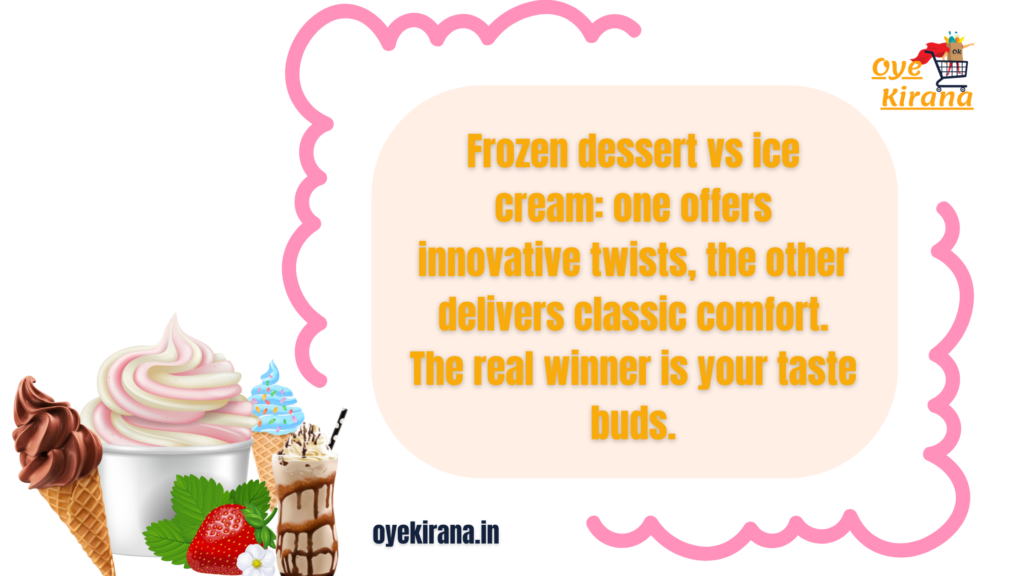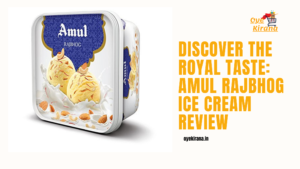When it comes to cooling off with a sweet treat, many people find themselves torn between frozen dessert vs ice cream. Both options offer a delightful way to satisfy a craving for something cold and creamy, but there’s a lot of confusion surrounding what exactly sets them apart. With so many products on the market, it’s easy to get mixed up about the differences, leading to questions about which one is the better choice. In this blog, we’ll clear up the confusion and help you understand what makes frozen desserts and ice cream unique.
What Is Ice Cream?
Ice cream is a frozen food made from a mixture of dairy products, primarily milk and cream, combined with sugar and other flavorings. It’s churned during the freezing process to create a smooth, creamy texture that people have loved for centuries.
- Key Ingredients:
- Dairy: The main ingredient is typically cream or milk, giving ice cream its rich and creamy consistency.
- Sweeteners: Sugar is commonly used, but other sweeteners like honey or maple syrup can also be found.
- Flavorings: From classic vanilla and chocolate to more unique flavors, there’s a wide range of options available.
- Stabilizers and Emulsifiers: These help maintain the texture and prevent ice crystals from forming.
- Texture and Creaminess: Ice cream is known for its smooth and creamy texture, which comes from the churning process. This process incorporates air into the mixture, creating a light and airy treat.
- Cultural Significance: Ice cream is not just a dessert; it’s a cultural icon. From childhood memories of summer cones to gourmet scoops in fancy restaurants, ice cream has a special place in many people’s hearts.
When considering frozen dessert vs ice cream, it’s important to recognize that ice cream’s rich, creamy texture and its deep cultural roots make it a standout choice for those seeking a traditional frozen treat.
What Is Frozen Dessert?
Frozen dessert is a broad category of cold treats made primarily from non-dairy ingredients, offering a versatile alternative to traditional ice cream. These products are crafted to cater to various dietary preferences or restrictions, such as lactose intolerance or veganism, making them an increasingly popular choice among health-conscious consumers.
- Key Ingredients:
- Non-Dairy Fats: Instead of cream or milk, frozen desserts use plant-based oils like coconut oil or palm kernel oil, which contribute to their unique texture and flavor.
- Sweeteners: Sugar is commonly used, but alternative sweeteners like agave or stevia may also be found.
- Flavorings and Additives: Frozen desserts come in a wide variety of flavors, from fruity sorbets to rich, chocolatey treats. Stabilizers and emulsifiers are also used to maintain a smooth texture.
- Variety of Products:
- Frozen desserts encompass a range of products, including sorbets, gelato, frozen yogurt, and dairy-free ice cream alternatives.
- Each type offers a different experience, from the refreshing, icy texture of sorbet to the creamy consistency of gelato.
When comparing frozen dessert vs ice cream, it’s evident that frozen desserts provide a broader selection of options, particularly for those seeking non-dairy or lower-fat alternatives. This variety makes frozen desserts a flexible and appealing choice for many.
What Are The Key Differences In Frozen Dessert Vs Ice Cream?
When choosing between frozen dessert vs ice cream, it’s essential to understand the key differences that set these two treats apart. Although they may look similar on the surface, their ingredients, texture, and nutritional profiles vary significantly.
- Ingredients:
- Ice Cream: Made primarily from dairy products like milk and cream, ice cream gets its rich, creamy texture from the fat content in these ingredients.
- Frozen Dessert: Instead of dairy, frozen desserts use plant-based oils such as coconut or palm kernel oil. This substitution gives them a different mouthfeel and texture compared to ice cream.
- Texture and Taste:
- Ice Cream: The churning process and high dairy content result in a smooth, creamy texture that many people love.
- Frozen Dessert: Depending on the oils and other ingredients used, frozen desserts can range from creamy to icy. The texture may be slightly different, and the taste can vary depending on the type of fats and flavorings used.
- Nutritional Content:
- Ice Cream: Generally higher in fat due to its dairy content, ice cream is also richer in calories. It can be a source of essential nutrients like calcium, but it may also contain more sugar.
- Frozen Dessert: Often lower in fat, especially saturated fat, frozen desserts can be a lighter option. Some are also dairy-free, making them suitable for those with lactose intolerance or who follow a vegan diet.
- Dietary Considerations:
- Ice Cream: Traditional ice cream may not be suitable for people with lactose intolerance, dairy allergies, or those following a vegan diet.
- Frozen Dessert: With options like dairy-free and vegan frozen desserts, this category caters to a wider range of dietary preferences and needs. It’s a great option for those looking for alternatives without sacrificing the enjoyment of a frozen treat.
When comparing frozen dessert vs ice cream, these differences can influence your choice depending on your dietary needs, taste preferences, and health considerations. Whether you’re looking for a traditional, creamy treat or a lighter, dairy-free option, understanding these distinctions will help you make an informed decision.

What Are The Consumer Preferences And Market Trends For Frozen Dessert And Ice Cream?
In the world of frozen treats, consumer preferences and market trends reveal fascinating insights into the choices people are making between frozen dessert vs ice cream. Here’s a look at how these trends are shaping the industry:
- Health-Conscious Choices:
- Many consumers are increasingly health-conscious, leading to a rise in demand for lower-fat, lower-sugar, and dairy-free options. This shift has popularized frozen desserts that cater to specific dietary needs, such as vegan or low-carb alternatives.
- Flavor Innovations:
- Both frozen desserts and ice cream are seeing a surge in creative and unique flavors. While classic favorites remain popular, consumers are also exploring adventurous flavors like matcha, lavender, and salted caramel.
- Premium Products:
- There’s a growing trend towards premium, artisanal ice cream with high-quality ingredients. People are willing to pay a bit more for a product that promises rich, indulgent flavors and a luxurious experience.
- Convenience:
- Convenience is a significant factor influencing consumer choices. Frozen desserts and ice cream are available in a variety of formats, including single-serve cups and larger family-sized tubs, catering to different needs and preferences.
- Environmental and Ethical Considerations:
- Shoppers are becoming more aware of the environmental and ethical aspects of their purchases. As a result, there’s an increasing demand for products that use sustainable packaging and ethical sourcing of ingredients.
When looking at frozen dessert vs ice cream, it’s clear that market trends reflect a broad spectrum of consumer preferences. From health-oriented options to indulgent treats, people are exploring a range of choices that fit their lifestyles and values.
Conclusion
When it comes to frozen dessert vs ice cream, it’s evident that both bring their own special qualities to the table. Whether you’re a fan of the classic, creamy goodness of ice cream or excited by the variety and health-conscious options of frozen desserts, knowing the differences helps you enjoy your treat even more.
We’re curious—what’s your go-to frozen treat? Drop a comment below to join the conversation! If you found this comparison helpful, give us a thumbs up and share it with friends who might be on the fence between these two delicious options. Your support means a lot and keeps us motivated to bring you more tasty content!




